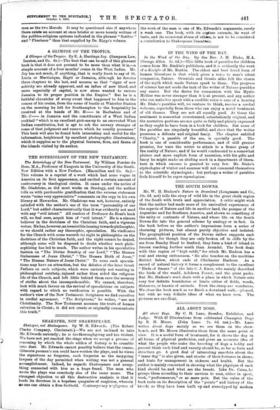THE SOUTH DOWNS.
Mr. W. H. Hudson's Nature in Dowaand (Longmans and Co., 10s. 6d. net) tells the story of wild life in the great chalk region of the South with truth and appreciation. A critic might wish that the author had made more of his unrivalled experiences of the aspects of Nature and life in another land, the pampas of the Argentine and far Southern America, and shown us something of the unity or contrasts of Nature, and where life on the South Downs fits into the general scheme by analogy or in fact. In the book before us the author's impressions form a series of charming pictures, but almost purely objective and isolated. The geographical position of the Downs rather suggests such treatment, for though they are only broken off in cliffs by the sea from Beachy Head to Seaford, they form a kind of island in Sussex reaching further south than Arundel. The book deals with this region of "high veldt," for which Mr. Hudson has a real and strong enthusiasm. 'He also touches on the maritime district below, which ends at Chichester Harbour. As a record of natural history it forma a complement to the excellent "Birds of Sussex " of the late C. J. Knox, who mainly described the birds of the weald, Ashdown Forest, and the great parks. But Mr. Hudson's work deals with a place in which Nature sets very few definite boundaries or limits either of fields, woods, distances, or haunts of animals. Even the sheep are wanderers. We close the book much as we finish a downland walk,—pleased, but with no very definite ideas of what we have seen. The pictures are excellent.


















































 Previous page
Previous page